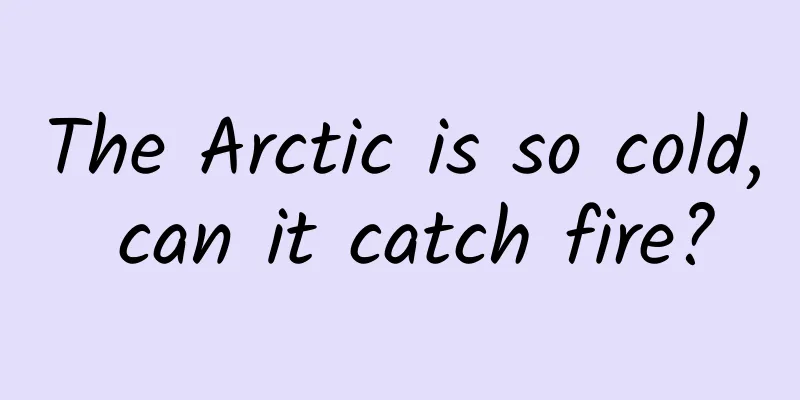The Arctic is so cold, can it catch fire?

|
Is the Arctic on fire? Author: Fan Gang You may find this title a bit confusing. Isn't the Arctic very cold? Isn't it all ice? How can there be a fire? In fact, this is a misunderstanding. The Arctic is a large area, and in the center is an ocean called the Arctic Ocean, which does freeze. But outside the Arctic, there are many islands and continents, and many places have forests. It is not all icy and snowy, which has the conditions for fire. If lightning strikes a tree, or someone throws a cigarette butt or something, it may cause a fire. For example, in June 2019, Alaska in the Arctic region suffered a serious fire due to a thunderstorm. The fire burned from summer to autumn and burned more than 400 square kilometers of land. What's more terrible is that in January 2020, smoke was seen again in the place where the fire had burned, and people realized that the fire was not completely extinguished. It just burned underground for 4 months and then rushed out. In fact, not only is it possible for the Arctic to catch fire, but it is also difficult to completely extinguish the fire. Why does this happen? You may already know that our planet is warming. Take this year for example, many cities in China have experienced unusually high temperatures. However, the speed of warming varies from place to place on Earth. Some places are warming faster than others. Unfortunately, the Arctic is an area that is warming particularly fast. In many places in the Arctic, there is something called "peat" on the ground. Peat is the lowest degree of coal, the most primitive state of coal, and its main components are some mosses and dead plant bodies. With the change of the surrounding environment, such as the increase of pressure, peat will become more solid. If peat is buried underground for a long enough time, it will turn into coal. In fact, in some places, peat is mined and used directly as fuel. In its natural state, peat has many pores, so it has a high water content and cannot be burned directly. However, due to the warming of the Arctic, peat in many places has dried up. As a result, it becomes particularly easy to burn, and like coal, it can burn for a long time once it is burned. Therefore, the fire in Alaska is particularly difficult to extinguish. That's not all. Peat burning releases a lot of carbon dioxide, and we all know what more carbon dioxide will lead to - it will make the earth warmer. In this way, Arctic fires are likely to become more frequent, and fires will release more carbon dioxide. In this way, it becomes a vicious cycle. Fortunately, the fires won't burn forever. When the summer is over, the temperature drops, and there are some rains, these fires will go out. However, next summer, there will definitely be fires again. As the climate warms, the threat of fires becomes more serious, and people must do everything they can to protect the people, infrastructure, and natural resources in the Arctic. This article is produced by Science Popularization China-Starry Sky Project (Creation and Cultivation). Please indicate the source when reprinting. |
<<: Insects that "hear all directions" have different ears
Recommend
Can you hypnotize a chicken by drawing a line in front of it? What kind of outrageous hypnosis is this?
In a video, we can see the following scene: A chi...
Pushing differentiation to the extreme: OPPO N3 full experience with electric rotating lens
There are not many domestically produced smartpho...
How much does it cost to develop a mobile app on the market in Jingdezhen?
Is it easy to be a mobile mini program agent in J...
How to effectively and accurately reach users with activities
In fact, in the user-operated activity-based mark...
ASM is expected to be launched in the second quarter. Will you catch up with the two-year bonus period?
1. What is the expected domestic launch date of A...
Application of the user pyramid model: Zhihu case analysis!
As the proposer of the user pyramid model, the id...
9.69 million RMB! A collectible Apple 1 computer for sale, which Jobs helped make 45 years ago
This article is reproduced from Leiphone.com. If ...
Evaluation of 35 charging cables: Is it a waste of money to spend 145 yuan on the cable?
On the sixth day of the Lunar New Year, a touchin...
Xi'an mid-to-high-end sauna and SPA studio, so comfortable that I went there several times a week
Xi'an Bath Club East Suburbs, South Suburbs, ...
Why was the earthquake in Hualien, Taiwan Province felt strongly in Jiangsu, Zhejiang and Shanghai?
According to the official measurement of the Chin...
Ding Dong! The fruity natural fragrance you ordered has been delivered
Produced by: Science Popularization China Author:...
Google confesses to providing employee data to the FBI
On December 23, 2014, Christmas Eve, Google infor...
In the dark forest, have we been exposed?
In 1920, General Motors hired American inventor C...
Baidu Map Marketing allows customers to find you at a glance!
Baidu map marketing uses Baidu maps as a display ...
The popular information flow advertising, how does it work?
Information feed ads first appeared on Facebook i...



![[Case] How does an e-commerce app develop an operation and promotion strategy from scratch?](/upload/images/67cc4e8168971.webp)





